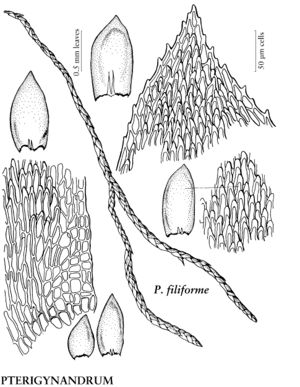familyPterigynandraceae
genusPterigynandrum
Show Lower Taxa
Pterigynandrum
Sp. Musc. Frond., 80, plates 16, 17, 18, figs. 1–5. 1801.
Etymology: Greek pter- , winged, gyne, female, and andros, male, presumably alluding to lateral position of gametoecia
| Taxon | Illustrator ⠉ | |
|---|---|---|
 | Pterigynandrum filiforme | Patricia M. Eckel |
Plants in pendent to prostrate mats, green to yellow-green. Stems freely and irregularly branched; paraphyllia absent or few. Leaves erect, somewhat falcate to homomallous, imbricate, oblongelliptic; margins narrowly reflexed proximally, erect and serrulate distally; apex obtuse to acute; costa double, short, narrow; alar cells weakly differentiated; laminal cells oblong-rhombic, prorulose abaxially, walls generally thick. Capsule erect, cylindric, symmetric.
Distribution
North America, West Indies, Central America, Europe, Asia
Discussion
Species 1.
Selected References
None.
Lower Taxa
... more about "Pterigynandrum"
symmetric +
erect +
cylindric +
differentiated +
single +
2-fid +
narrow +
Greek pter- , winged, gyne, female, and andros, male, presumably alluding to lateral position of gametoecia +
imbricate +
erect +
serrulate +
prostrate +
pendent;prostrate +
absent +
foliose +
Sp. Musc. Frond., +
1801 +
often somewhat larger +
branched +
erect;more or less creeping +
Pterigynandrum +
Pterigynandraceae +
genus +
thick +
wiry +
small +